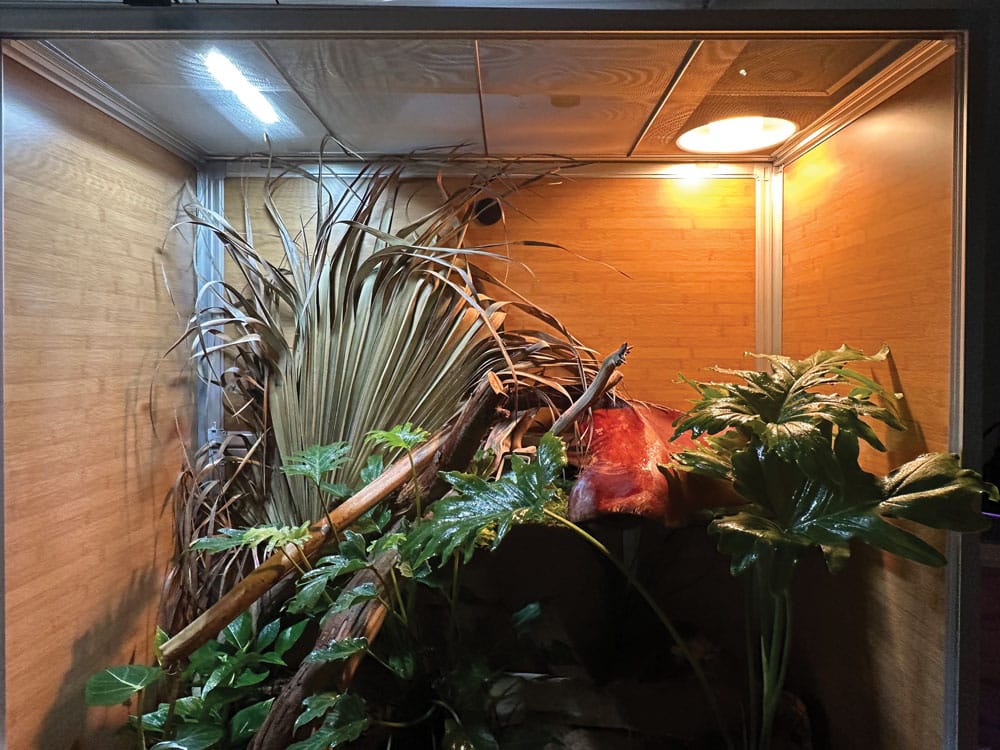The Zen Habitats Meridian enclosure came essentially pre-built.
Ball pythons are an interesting species. Easily the most popular pet snake, Python regius come from the hot and humid regions of Africa in localities that range from the rainforests of Nigeria to the grasslands and open forests of Ghana, Benin and much of the rest of Sub Saharan Africa. When I acquired my second ball python, a pastel fire/vanilla morph named Kasserole, I kept him in a 40 gallon enclosure with some big branches and a commercial hide. This size enclosure is adequate but in my opinion, more space is always better, especially as he grows larger.
Junior, my normal ball is in a 4’x2’x2’ enclosure and he often can be found atop one of the branches in his enclosure. These mostly shy snakes spend, depending on their locality, a lot of their time in underground burrows in the wild, but that doesn’t mean they don’t climb, and it doesn’t mean they have to be relegated to a tub or rack when kept in captivity. While some folks keep these animals in tubs or in rack systems, I personally prefer to see my snakes in the most naturalistic enclosures that I can conjure, and with the most visibility but with plenty of hiding places.
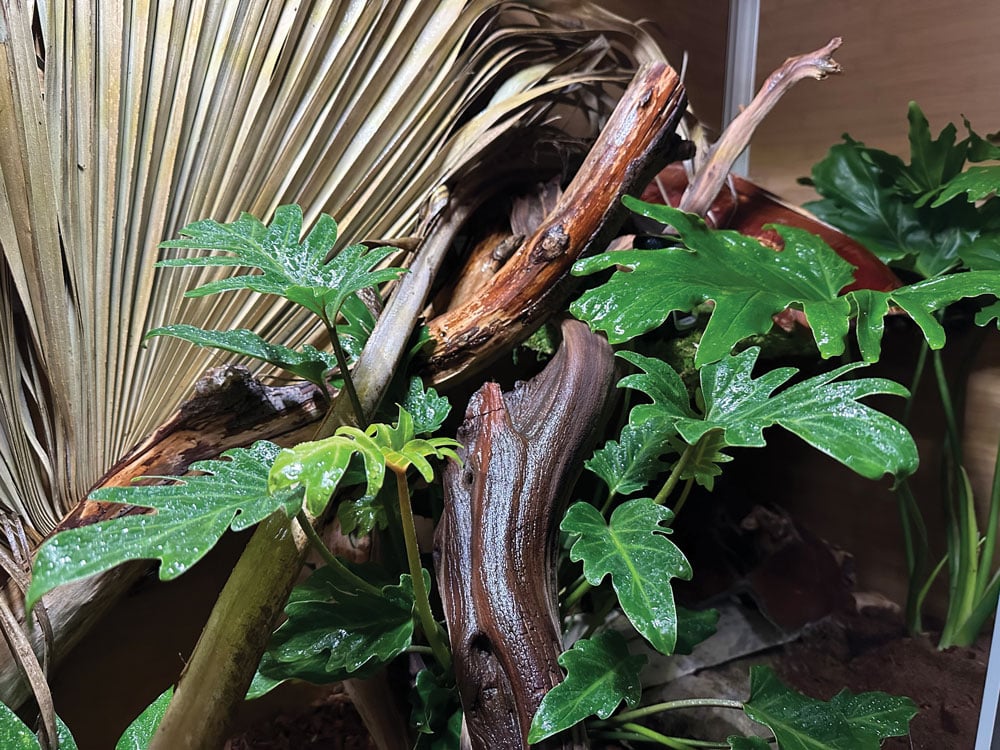
Some live plants and a palm frond, and some driftwood.
Zen Habitats sent a Meridian 4’ x 2’ x 4’ PVC enclosure for review and this enclosure has maximum visibility. At four feet tall, the Meridian enclosure sports large acrylic doors that enable you to peer directly into the enclosure with zero obstacles. Because it is so tall, my first inclination was to figure out how to use the extra vertical space.
The Zen Habitats Meridian enclosure came essentially pre-built. The company has an assembly video on YouTube, and following it, the assembly took about 20 to 30 minutes. While one person can assemble this enclosure, a second set of hands helped in my case as the walls can get a bit unwieldy as they are pre-attached. I broke a pin on one of the latches during assembly. The company promptly sent a replacement pin.
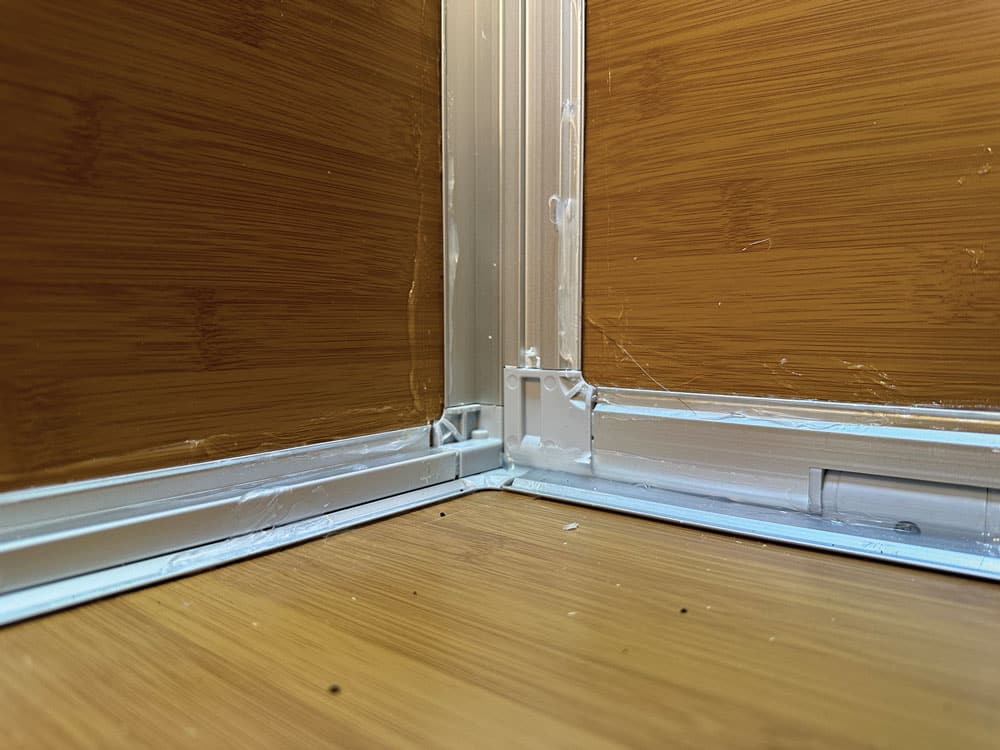
The first step was to seal the bottom up to the top of the substrate barrier with aquarium sealant.
There is no need for a rubber mallet with this enclosure. In this case, my teen daughter helped with the assembly. She has been going with me to reptile shows since she was 5 years old, and even served as a helper to the late Russ Case (longtime editor of this magazine) at several of the Southern California shows.
The enclosure comes with either a screen mesh barrier or an acrylic barrier at the bottom. The screen mesh provides more airflow for those animals that need it. I went with the acrylic barrier to keep the substrate, and the humidity, in.
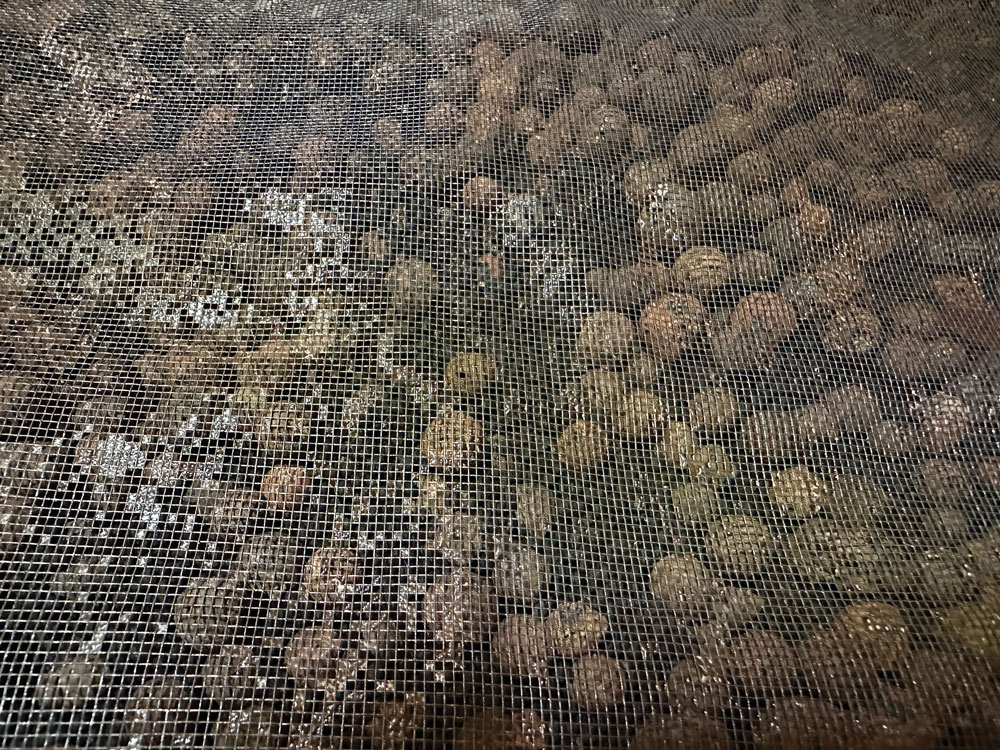
A combination of Zoo Med Hydroballs and leftover Exo Terra Sub Stratum was placed over a plastic shield. A substrate barrier was placed on top of the drainage layer.
With the enclosure fully assembled, the first order of business was to seal the bottom. To achieve this, I used aquarium sealant on all the seams up to the height of the substrate barrier. This will help to keep any moisture from leaking out of the enclosure. After sealing the enclosure, I placed some plastic sheeting down to further prevent moisture from reaching the bottom of the enclosure. I then put down a layer of Zoo Med Hydro Balls as well as some leftover Exo Terra Sub Stratum from my crested gecko build. Placed over this was a screen mesh to prevent the Zoo Med Reptisoil and Prococo bedding from getting into the drainage layer.
With the substrate prepped and ready I planted four different plant species, all low light or low light exposure plants (3 to 7 hours a day) plants: Philodendron gloriosum, Philodendron xanadu, Philodendron selloum and Pothos wick. For lighting, I went with an Exo Terra Terrasky Planted Terrarium Light that I purchased on sale for $50 at my local big box pet store. These plants should fill out nicely the extra vertical space afforded by the enclosure.
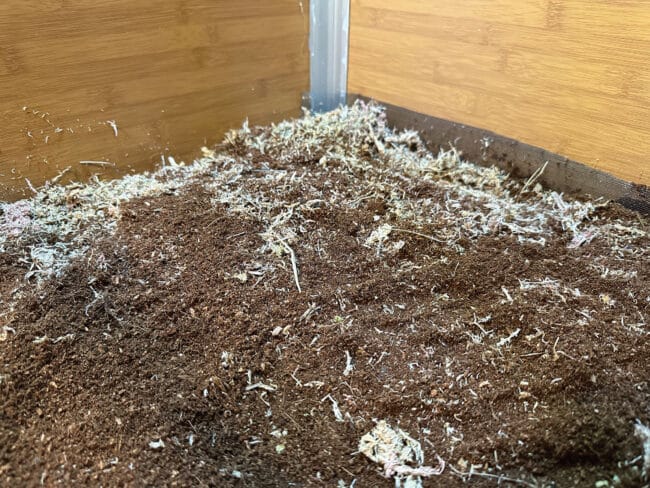
The soil substrate with some sphagnum moss.
This light is 12 watts in total and features 24 bright white 6500K LEDs, 12 tricolored RGB LEDs and includes 11 presets (cloud cover, sunrise, sunset, moon, storm & lightning) and six pre-programmed color settings. The included remote control enables you to create and store your own custom settings. The light system is also rated IP84 for humid environments. I’ve had the enclosure setup for nearly three months (as of this writing, and so far, the plants are doing well.
Because the Meridian enclosure is four feet tall, I was concerned with how Kasserole would get proper heat. Undertank heat pads are designed for glass enclosures so those were out. I didn’t want to go the radiant heat panel route as I was going for the most naturalistic look for the enclosure, and the environment in which I live doesn’t get too cold. A ceramic heat emitter would work at the expense of losing humidity, but I didn’t want a heat lamp on at night.
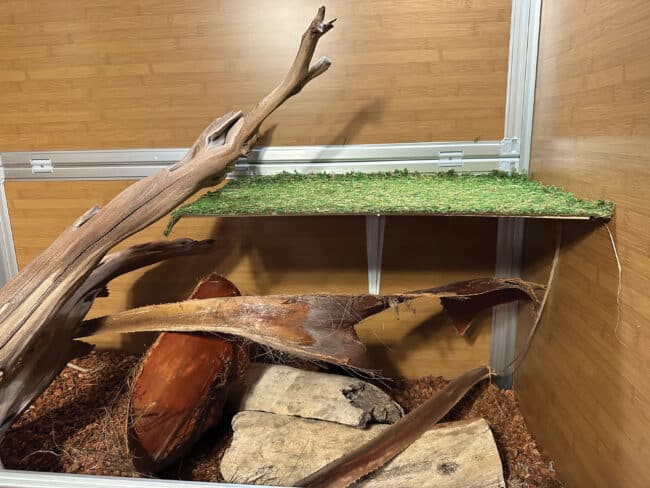
The PVC platform is 23” x 15″.
Southern California is not so extreme weather wise, and I could get away with turning off a heat lamp at night, as that is what I do with my kingsnake and hognose, but ball pythons need steady heat all the time. And coupled with the fact that the enclosure is so tall, any heat from the top would find a hard way to get to the bottom because, well heat rises. I needed to get Kassie closer to the heat source. So what to do? Zen Habitats has a nice build on YouTube for their ball python, Chip, using the same 4’ x 2’ x 4’ sized Meridian enclosure (the enclosure used in that build required a more involved assembly). To address the heat challenge, two platforms were built for Chip.
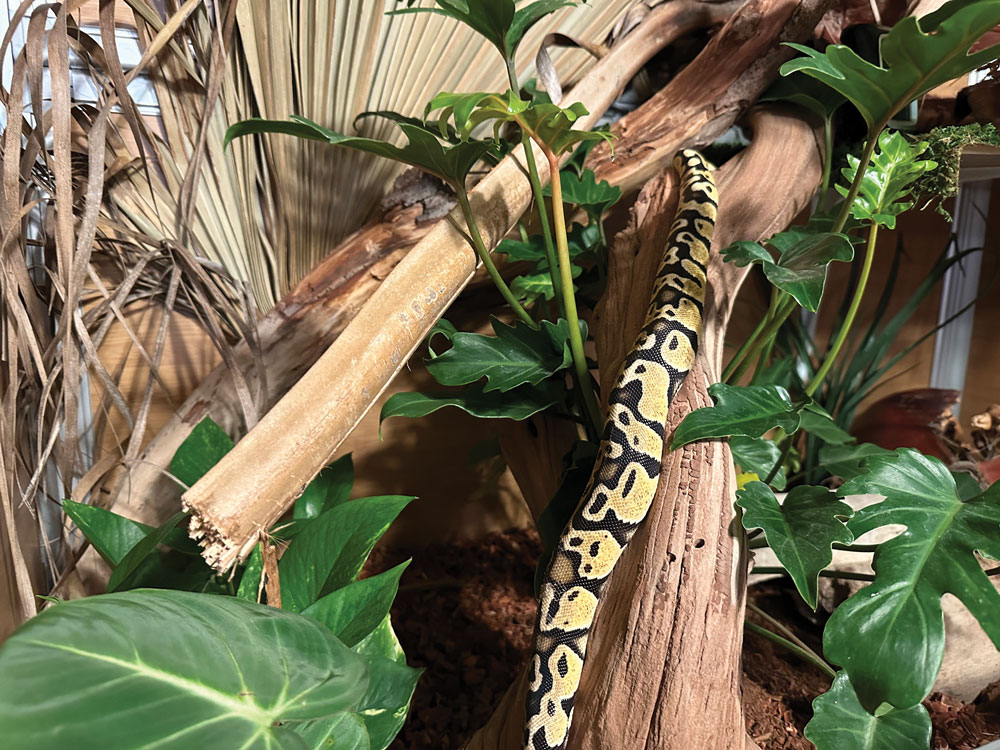
Kasserole climbing up to his perch.
For Kasserole, I built a single, 23” x 15” platform, as adding a second platform on the other side of the enclosure would prevent the plants from getting any light. The platform is a spare Zen PVC piece and a standard shelf arm purchased at Lowe’s. I drilled some screws into the enclosure to fasten the shelf arm to the PVC piece. I then shaved down the screw ends and glued a 23” x 17” piece of Galapagos CrashPad Mossy Terrarium Liner onto the PVC. The platform sits 26 inches from the top of the mesh screen. The platform has two palm frond pieces I picked up at Bolsa Chica State Beach in Huntington Beach, CA. These are perfect natural hides. This is where Kassie spends most of the day time.
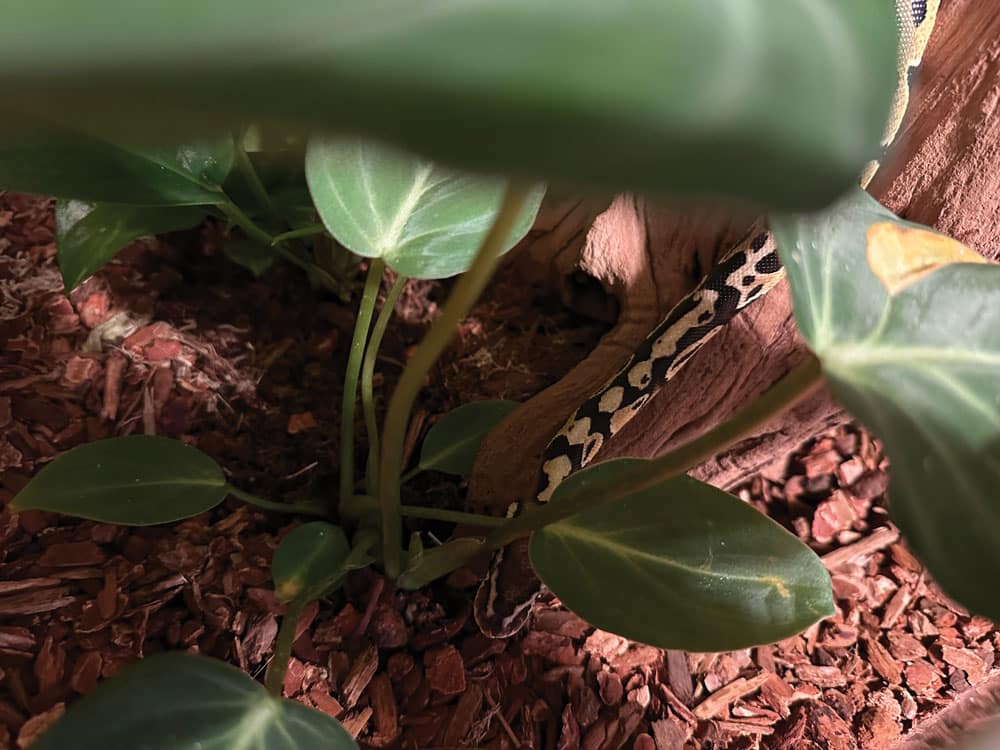
The enclosure has plenty of places for Kasserole to hide.
At the substrate level I have four pieces of driftwood, also gathered on the Bolsa Chica State Beach, a piece of 3 foot hardwood and two pieces of Zoo Med Mopani wood I purchased at a reptile show. The hardwood and another piece of driftwood are set at an angle and lean up on the platform. These serve as a ladder for Kasserole to climb down to the bottom of the enclosure from his perch on the platform. A palm frond at the back of the enclosure serves as an aesthetic piece, designed to have the look of the African environment that ball pythons are from.
The Mopani wood is covered in a big palm frond. This serves as Kasserole’s second hide, essentially on the first floor.
Zen Habitats also includes an acrylic cover that is placed on the top of the screen to help with humidity. With the cover in place, there is a nine inch gap for lighting and heat accessories. Here I have a Zoo Med Mini Combo Deep Dome Dual Lamp fixture running a Repti Tuff 75 watt halogen lamp and an Exo Terra 100 watt night heat lamp. Both sit above the screen mesh. The acrylic doors are the final piece of the assembly.
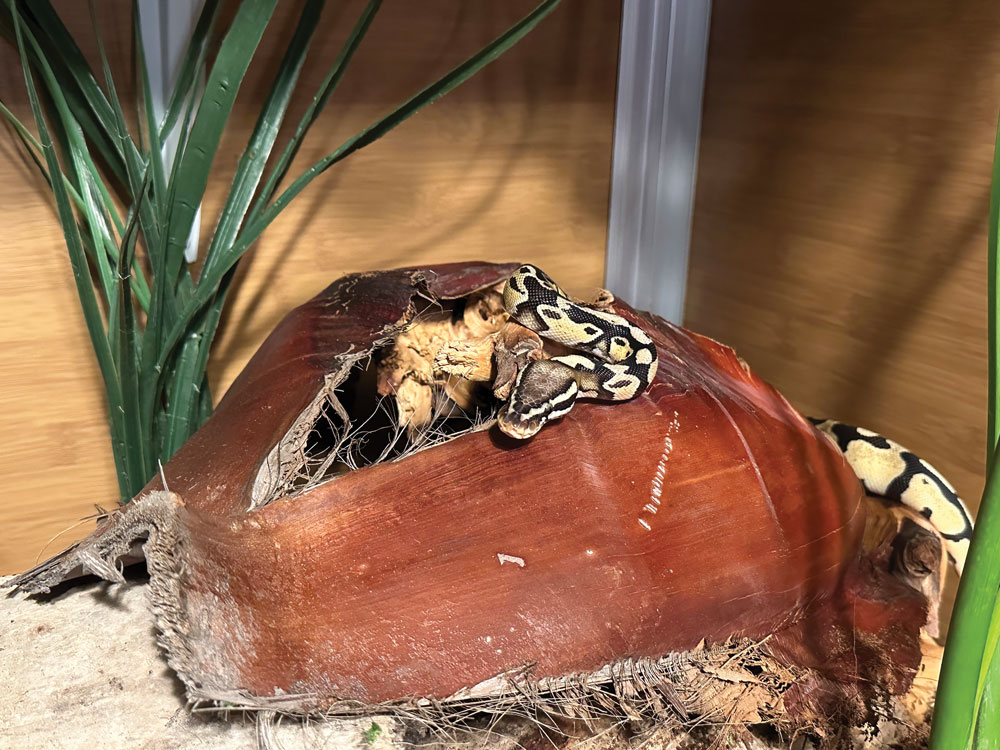
Kasserole peeks out of his hide.
In my opinion, ball pythons deserve better enclosures than your standard tub or breeder racks. These racks were initially designed for rodents. They are a beautiful animal that deserves to be seen and not hidden away in a plastic tub. And they are indeed semi-arboreal. A 1998 study “Sexual size dimorphism and natural history traits are correlated with intersexual dietary divergence in ball pythons from the rainforests of southeastern Nigeria,” that looked at the food composition of ball pythons in southeastern Nigeria found that both male and female ball pythons ate birds in addition to small mammals. That study determined that male ball pythons in that locality ate birds more frequently than females while females ate more mammals. It also found that smaller balls, those shorter than 70 cm (27 inches) in total length almost exclusively ate small birds (nestlings and hatchlings) while those snakes that exceeded 100 cm (39 inches) in total length ate mostly small mammals. The study suggested that males from this locality were more arboreal than females.
Ball Python History, Care And Breeding
Another study “Animal-appropriate housing of ball pythons (Python regius)—Behavior-based evaluation of two types of housing systems” looked at 35 ball pythons housed in rack or tub systems for 8 weeks and then compared their behavior when housed in more elaborate enclosures. That study, Animal-appropriate housing of ball pythons (Python regius)—Behavior-based evaluation of two types of housing systems, can be read here.
My advice is if you have the room, check out the larger, 4’ x 2’ x 4’ Zen Habitats Meridian enclosure for your ball python. It is a large enclosure and the front viewing space is massive. Go bioactive and outfit it with plenty of climbing branches and just see how your ball python interacts with his or her environment. While Kassie spends the vast majority of his time on his platform, above the floor, I do find him climbing down to the floor of the enclosure, exploring about, especially at night. Enrichment is key to the health of your reptiles, and the Meridian enclosure provides plenty for Kassie to do.

